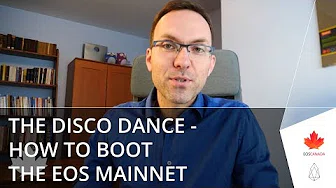eos-bios is a command-line tool for people who want to kickstart a
blockchain using EOS.IO Software.
It implements the following:
- Multi-staged launch of the mainnet
- Booting local development environments
- Booting testnets
- Booting consortium or private networks
The first you need to know is the discovery protocol. See an introduction here:
Jump directly to the sample configurations if you know what you're doing.
Other videos explaining the different concepts of eos-bios:
| Description | Link |
|---|---|
| Details of the Discovery file | https://youtu.be/uE5J7LCqcUc |
| Network meshing algorithm | https://youtu.be/I-PrnlmLNnQ |
| The boot sequence | https://youtu.be/SbVzINnqWAE |
| Code review of the core flow | https://youtu.be/p1B6jvx25O0 |
| The hooks to integrate with your infrastructure | https://youtu.be/oZNV6fUoyqM |
Some Q&A related to eos-bios:
| Description | Link |
|---|---|
| Are accounts carried over from stage to stage? | https://youtu.be/amyMm5gVpLg |
| How block producers agree on the content of the chain? | https://youtu.be/WIR7nab40qk |
Download eos-bios from the releases section here on GitHub,
clone this repository and copy the sample_config to a directory of
your choice.
Modify the my_discovery_file.yaml to point to a local address:
target_http_address: http://localhost:8888
Then run:
./eos-bios boot --single
This gives you a fully fledged development environment, a chain loaded with all system contracts, very similar to what you will get on the main network once launched.
The sample configuration sets up a single node, as it doesn't point to
other block producer candidates (skips the peers discovery).
When the time comes to orchestrate a launch, everyone will run:
./eos-bios orchestrate
According to an algorithm, and using the network discovery data, each team will be assigned a role deterministically:
- The BIOS Boot node, which will, alone, execute the equivalent of
eos-bios boot. - An Appointed Block Producer, which executes the equivalent of
eos-bios join --validate - An other participant, which executes the equivalent of
eos-bios join
The orchestrate for all will wait the agreed upon
seed_network_launch_block, and then do the dance.
Ask anyone on the latest seed network to invite you. They will run:
./eos-bios invite [youraccount] [your pubkey]
This will create your account on the seed network. Tweak your my_discovery_file.yaml:
seed_network_account_name, make it match what you provided for an invite.seed_network_http_address, this should be the address of the seed network you want to orchestrate from.
Also add your seed account private key to privkey.keys. This will allow you to run:
./eos-bios publish
You will want to tweak those values in your my_discovery_file.yaml also:
target_http_addressis the address to reach the node you're booting for the next stage.target_p2p_addressis a publicly reachable address advertised to mesh the networktarget_appointed_block_producer_signing_keyandtarget_initial_authority: these will be injected on the newly created blockchain astarget_account_name.seed_network_peersthis one warrants its own section.
Other notable fields:
seed_network_launch_blockis the target block on the seed network which will unleash anorchestrated launch.target_contentsare all the pieces of content we need to agree on that will make it into the chain, like system contracts, ERC-20 snapshots, etc..
Review your my_discovery_file.yaml (see previous section). Then run:
./eos-bios boot
This will test your hook_boot_*.sh hooks.
When you do point to a seed network (in your config), you can:
./eos-bios discover
and this will print the peers, their relative weights, etc..
The seed_network_peers section of your discovery file looks like this:
seed_network_peers:
- account: eosexample
comment: "They are good"
weight: 10 # Weights are between 0 and 100 (INT value)
- account: eosmore
comment: "They are better"
weight: 20
This means you are comfortable launching the network with both
eosexample (at 10% vote weight), and eosmore (at 20%). eos-bios
will compute a graph of the network based on that peering information.
These are all account names on the seed network used to boot a new network.
-
Are they competent and capable persons? Can they fix the network if it goes awry?
-
Are they providing a solid and tested infrastructure? Can be stay on schedule and produce blocks until we reach the 15% threshold ?
-
Do they fully understand the boot sequence ? Do they understand all actions that need to be processed in order to have a chain that qualifies as mainnet. (they decide on boot_sequence.yaml)
-
Can they compile system contracts and compare their source code, making sure that the proposed contracts are legit, do not contain rogue code, etc.. (they decide on target_contents)
-
Do they understand how to make sure the snapshot.csv is valid, up-to-date and reflect the last Ethereum snapshot ? (they decide on snapshot.csv)
-
Can they properly boot the network and have they practiced being the BIOS Boot node.
-
Can they properly boot a node and mesh into the network, have they practiced
join?
The reason for those is because of the design of eos-bios .. votes
determine who gets which role, and based on the role you have, you
have critical decisions to make and the community relies on you for
the critical things, in the order above.
We keep an updated list of the different stages launched with eos-bios here:
You can download the latest release here: https://github.com/eoscanada/eos-bios/releases .. it is a single binary that you can download on all major platforms. Simply make executable and run. It has zero dependencies.
Alternatively, you can build from source with:
go get -v github.com/eoscanada/eos-bios/eos-bios
This will install the binary in ~/go/bin provided you have the Go
tool installed (quick install at https://golang.org/dl)
Add -u to go get to pull updates.
On Telegram through this invite link: https://t.me/joinchat/GSUv1UaI5QIuifHZs8k_eA (EOSIO BIOS Boot channel)
See the previous proposition in this repo in README.v0.md
- Did I update my
target_p2p_addressto reflect the IP of the NEW network we're booting ? - Did I update my
target_http_addressto point to my node, reachable fromeos-bios's machine ?
-
Do your
PRIVKEYandPUBKEYinhook_join_network.shmatch what you published in your discovery file undertarget_initial_authorityandtarget_initial_block_signing_key? -
Forked ? Did someone point to an old p2p address ? If so, remove them from the network.
